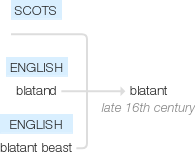Blatant
late 16th century: perhaps an alteration of Scots blatand ‘bleating’. It was first used by Spenser as an epithet for a thousand-tongued monster produced by Cerberus and Chimaera, a symbol of calumny, which he called the blatant beast . It was subsequently used to mean ‘clamorous, offensive to the ear’, first of people (mid 17th century), later of things (late 18th century); the sense ‘unashamedly conspicuous’ arose in the late 19th century.
wiktionary
Coined by Edmund Spenser in 1596 (“blatant beast”). Probably a variation of *blatand (Scots blaitand(“bleating”)), present participle of blate, a variation of bleat, equivalent to blate + -and. See bleat.
etymonline
blatant (adj.)
coined 1596 by Edmund Spenser in "The Faerie Queen," in blatant beast, a thousand-tongued monster representing slander; perhaps primarily alliterative, perhaps suggested by Latin blatire "to babble." It entered general use by 1650s as "noisy in an offensive and vulgar way;" the sense of "obvious, glaringly conspicuous" is from 1889. Related: Blatantly; blatancy.
